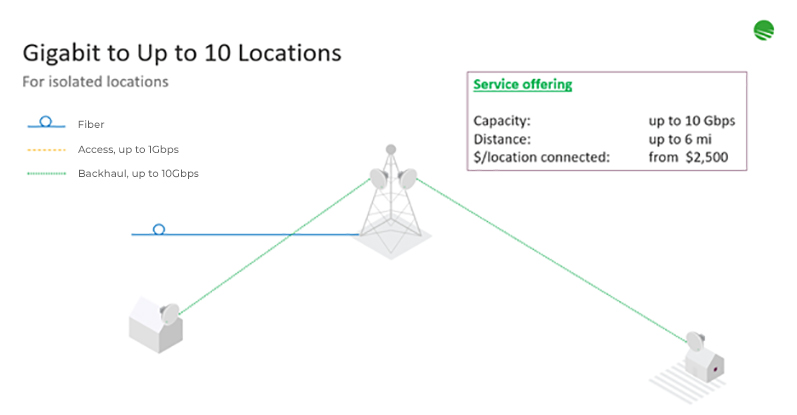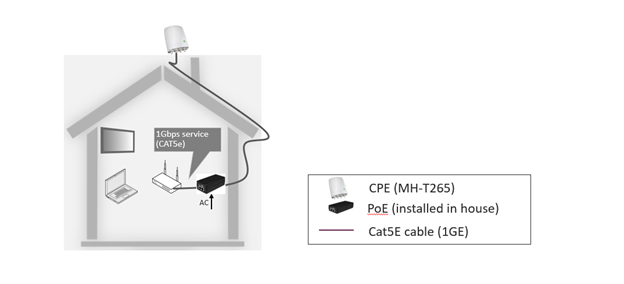There has been a ton of talk about the RDOF auction, who won and what services they are targeting. For those winners who promise to deliver Gigabit services, much of the attention has been on using fiber as the connectivity solution. However as many may not be aware, there are wireless solutions available today that are widely used to deliver gigabit services. It is another tool in the service providers arsenal to provide connectivity, along with fiber and other technologies. This blog is a guidebook to RDOF winners who plan to deploy wireless as part of their network and explains how to comply with RDOF requirements in the response communication with the FCC.
To qualify for RFOD funding, each winning bidder should submit FCC Long Form 683 with details about its operation, legal, funding, and technical aspects of the solution. The relevant questions for a wireless solution are on pages 23-25 of the form:
- Spectrum Access
- Technology and system design description
Additional questions can be found in the Procedures for Rural Digital Opportunity Fund Auction which contains the operational questions from the short form in Appendix A and on pages 96-98, under the term “Terrestrial Fixed Wireless”.
This document is intended to assist service providers in replying to the RDOF technology-related questions using a gigabit fixed wireless access solution.
Spectrum Access – Long Form 683
Identify the spectrum band(s) that will be used for the last mile, backhaul, and any other part of the network and identify which bands each part of the network will be deployed in. Describe the total amount of uplink and downlink bandwidth (in megahertz) that is available and supported by mmWave systems in each spectrum band.
To comply with RDOF requirements and deliver Gigabit capacity with low latency using Gigabit Wireless Solutions, the service provider will utilize both 60GHz (V Band) and/or 70/80 GHz (E Band) spectrum.
The V Band frequency band ranges between 57GHz to 71GHz and offers 14GHz of a license-free spectrum. There are many commercially available point-to-point and point-to-multipoint products, operating in this band and able to deliver multi-gigabit services. The capacities of these systems range from 1Gbps up to 3.8Gbps aggregate with TDD Duplexing. The prime use case of this technology is for last-mile access – i.e. the actual connection to the home, residence, or devices like WiFi APs, to the network transport.
E band is defined as a paired spectrum between 71-76 GHz and 81-86GHz. This is a lightly licensed band, requires link registration but provides the benefit of registered microwave radio. The cost of the license is $75/10 years per point-to-point link. More details about the registration procedure can be found here. Commercially available systems operating in this band can deliver 10Gbps of Full Duplex capacity, which means 10 gigabits per second in the downlink and 10 gigabits per second in the uplink.
Figure 1 below defines these further

Technology and System Design Description
Building Blocks of a Gigabit Wireless mmWave Solution: Point to Point
Siklu offers a broad portfolio of Gigabit solutions, each designed for a specific application and/or portion of the network. For high capacity, point-to-point connections, be they backhaul or direct access to a large MDU or facility, EtherHaul™ radios, and more specifically the EtherHaul™ 8010 operating in the E band are the right choices.
E-band PtP radio: EH-8010

These devices are point-to-point radios that are usually installed on towers or roof-tops.
Capacity: up to 10Gbps FD
Distance: up to 6 miles, line of sight
Interface: Ethernet, fiber, and copper
Building Blocks of a Gigabit Wireless mmWave Solution: Mesh
Connecting the homes or residential units can be accomplished with Siklu’s Terragraph mesh product line. The MultiHaul™ TG solution consists of a hub or Distribution Node (DN), and Terminal Unit (TU). With one-step configuration and beam steering, deploying these units consists almost exclusively of physical installation and connecting to power.
V-band Mesh-PtMP radio: MH-N366

These devices are usually deployed at the street level or single-family home rooftops, and bridge the last 1,000 ft to deliver gigabit capacity to the end-users.
MH-N366:
Capacity: up to 15Gbps, with 360 deg. omni coverage, up to 60 terminals
Distance: up to 1,000 feet, line of sight
Interface: Ethernet, copper, and fiber
TU - 265:
Capacity: 1Gbps
Distance: up to 1,000 feet, line of sight
Interface: Ethernet, copper, and fiber
Typical Topologies using Siklu point to point and Mesh systems
While every network is unique based on the specific location of customers, Internet POPs, terrain, and more, in this next section we present two generic topologies that are commonly used.
Gigabit to isolated locations – suitable for up to 10 locations
This solution relies on gigabit point-to-point radios. One radio is installed on a tower or a tall building that has a fiber point of presence. The second side is installed on the customer premise. To provide the gigabit service the radios should operate in mmWave frequency and can co-exist with other radios in this band without causing interference. The solution will provide a gigabit service of 10Gbps Full Duplex with a radius of up to 6 miles. This requires a single cable installation supplying PoE or DC power.

Gigabit to pocket communities – suitable for 100’s of locations
This use case assumes some level of residential density. The solution includes 2 components: the backhaul link that is described in the previous paragraph and the mesh access network. The DN provides 360 coverage and a range of up to 1,000 ft. The DN can serve up to 60, gigabit-capable TUs. This is the most cost-efficient technology to provide gigabit access. The $/home passed starts from $100.


The unit is connected using CAT5 cable through the PoE to the residential gateway/wifi router.
More information can be found on Siklu’s partners portal:
- EH-8010
- MH-N366
Terrestrial Fixed Wireless (TFW) Long Form Requirements
Per the referenced RDOF Public Notice, and specifically for the section covering Terrestrial Fixed Wireless networks, the response must contain:
- Performance at peak usage with calculations to show how this is achieved.
- Coverage Maps of the TFW network that will be used showing where upload/download speeds will meet or exceed gigabit performance.
- Details and specifications for the RAN system used to generate the coverage map and performance delivered. Each RAN design must include a full description including but not limited to lat/long location, antenna height, orientation, model EIRP.
Actual RDOF questions and responses are listed below point by point.
Provide the calculations used, for each performance tier and frequency band, to design the last-mile link budgets in both the upload and download directions at the cell edge, using the technical specifications of the expected base station and customer premise equipment. Submit assumptions regarding fading statistics, cell edge probability of coverage, and cell loading for each relevant performance tier.
- The performance of every wireless system is subject to environmental conditions and the required availability. The radio performance is calculated using industry-standard ITU propagation models: ITU-R P.837-5 and ITU-R P.838-3 and system gain of the radios. These models consider rain attenuation and oxygen absorption to provide a reliable performance estimate.
- Performance calculation for all Siklu radios can be calculated using an online Link Budget Calculator: http://lbc.siklu.com/
- Siklu also provides PathLoss file to all the radios, it can be found on the customers portal.
Provide coverage maps for the planned and/or existing networks that will be used to meet the Rural Digital Opportunity Fund public interest obligations, indicating where the upload and download speeds will meet or exceed the relevant performance tier speed(s). The coverage maps should be provided for each interim and final service milestone and should display the required service areas and target locations (or a representation thereof).

- Siklu has developed a wireless planning tool, WiNDE, to simplify the planning process of advanced gigabit wireless networks.
- With WiNDE you can design a gigabit wireless network using the most advanced Terragraph technology in just a matter of minutes. The tool generates BOMs and instantly calculates the performance of every element of the network.
- The tool is suitable for any use case: business connectivity, residential FWA, smart city wireless network, and RDOF rural designs.
- Using WiNDE you can easily integrate new designs with existing ones, identify RDOF service areas, and even individual customers, add resiliency and point-to-point connections, and more. WiNDE supports networks of any size.
- To start using WiNDE: https://planner.siklu.com/ If you need help using WiNDE please contact support@siklu.com for assistance.
Provide detailed radio access network (RAN) infrastructure information used to generate the coverage maps for each unique cell including longitude, latitude, antenna height, antenna orientation, antenna down-tilt, antenna model, antenna system configuration, effective radiated power, operating spectrum amount, operating spectrum type, and operating radio technology.
- Detailed RAN design is generated using WiNDE, Siklu’s planning tool. Please contact support@siklu.com for assistance.
Describe the underlying propagation model used to prepare the coverage maps and how the model incorporates the operating spectrum, antenna heights, distances, fading statistics, terrain resolution, and clutter resolution.
- The radio performance is calculated using industry-standard ITU propagation models: ITU-R P.837-5 and ITU-R P.838-3 and system gain of the radios. These models consider rain attenuation and oxygen absorption to provide a reliable performance estimate.
Describe the underlying cell site and generally, radio frequency (RF) access network capacity management and traffic engineering models or concepts. Also describe any adjunct carrier aggregation or spectrum sharing techniques and if the proposed system could accommodate these features, if needed.
- All Siklu equipment implements the Layer2 protocol. To implement capacity management and traffic engineering, the following supported protocols can be used:
- Transparent bridge IEEE 802.1d
- VLAN IEEE 802.1q
- Provider bridge IEEE 802.1ad
- The management of the equipment is implemented using CLI/SSH/SNMP protocols.
- Detailed equipment specifications can be found in the customer portal:

Describe, for each relevant performance tier and latency combination, the base station equipment that the long-form applicant plans to use.
Describe the planned customer premise equipment configuration.
- In most of the residential deployments, the CPE that will be used is MH-T265. This unit has one copper Gigabit-Ethernet port and is powered by PoE. More detail on the TU cn be found at MH-T265 Terminal datasheet.
From Page 23 of the Public Notice: Describe the authorizations (including leases) it has obtained to operate in the spectrum.
- E-band is a lightly licensed band. Each link should be registered with the FCC. It costs $75/link for 10 years. The registration is done online. Siklu provides a comprehensive guide on how to register the link, it can be found here. Siklu also offer a service and will register the radios for you: https://www.siklu.com/support/online-fcc-link-registration/.
RDOF as a program represents both an opportunity and a challenge. The challenge being how to navigate the FCC rules and requirement. This blog should give readers a solid overview of the program and how Fixed 5G Wireless systems from Siklu can help you meet the Gigabit tier service level.